We experience a wide range of emotions from the very moment we are born.
Recognising emotions, understanding why we feel them and developing our emotional vocabulary all come gradually with time and experience. Our understanding of emotions usually begins by observing others during early childhood, but it’s not easy for everyone to develop an emotional vocabulary.
The previous post in this emotional literacy series defined emotions and feelings and looked at how supporting children with identifying emotions benefits them. In this post, you’ll find activity ideas for helping your child learn to recognise and name six core emotions.
Affiliate Disclosure: This post may contain affiliate links. This means that I may receive a small commision – at no cost to you – if you make a purchase through these links. Thank you for your support!
Emotional Vocabulary for Core Emotions
Emotions are complicated! Without directly experiencing specific emotions, the idea of some can be abstract and too hard to understand – especially for kids. After all, we don’t really expect young children to express that they are feeling ‘euphoric’ or ‘apprehensive’. So we start with the basics…
There are various schools of thought on how many ‘core emotions’ there are and how they are categorised, but the majority include around six to eight distinct emotions.
What are core emotions?
Popular theories include the following as basic emotions:
- Happiness
- Sadness
- Anger
- Fear
- Disgust
- Surprise
More complex emotions tend to be varying shades and intensities of the core emotion. For example, ‘irritation’, ‘annoyance’ and ‘rage’ are all varying shades of anger. For links to further reading in this area, see the links box at the end of this post.
03 Ideas for Developing Core Emotional Vocabulary
Before expanding children’s emotional vocabulary with words for complex emotions, let’s look at some ideas and activities that you can do with your child to help them understand these six core emotions. These ideas are suitable for young children and older children who find it difficult to identify and express emotions.
01 – Label their feelings
This is an effective technique that can be done in the moment when you see your child expressing an emotion. It’s as simple as noticing their feelings and letting them know that you see them. This shows that you understand how they are feeling, which validates the emotion they experience.
Labelling their feelings may look like this:
“You seem sad that we need to leave the park now. It’s hard to stop doing something when you are having fun.”
Or, “I saw your friend ignore you when you tried to play with them. It’s okay to feel upset – it hurts when it feels like someone doesn’t care about you. I would feel upset too.”
When you validate emotions, you aren’t necessarily agreeing that they should feel that way or that you think it is the right response. What you ARE doing is showing that you see them, hear them and that you care about their feelings without any judgement or shame.
Emotionally validated children are better equipped to develop strong self-worth and feel like they matter. On the other hand, if children are emotionally invalidated, it is deeply upsetting and painful. It can also lead to long-term emotional health issues.
02 – Lead by example
Modelling using emotional vocabulary by telling your child about situations you experienced either during your day or as they happen reinforces language and opens up doors for communication.
Using specific words to talk about your own emotions normalises them and provides a scaffold for your child to be able to talk about their feelings.
Modelling talking about feelings could look like this:
“I felt so nervous waiting for my job interview this morning, my heart felt like it was beating really fast and my palms were getting sweaty! I took some deep breaths and reminded myself that I spent time preparing and am qualified to do the job and I think the interview went well. I’m proud of myself for doing it!”
Talking like this with children helps emotional language to take root in children’s vocabulary. It also helps them to link physical sensations that come with emotions with appropriate coping strategies.
03 – Emotional vocabulary building through play
Learning through play is always a winner! Play-based learning is active and multi-sensory, which means children are using their brains in lots of different ways.
Here are a few ideas for emotional vocabulary-building games:
Feelings charades
One person chooses an emotion and mimes it for others to guess.
Mirror games
For children who find identifying emotions on other people’s faces difficult, you can adapt feelings charades by getting them to mimic your facial expressions whilst looking into a mirror. It can be easier to recognise expressions on their own faces.
Matching games
I’ve made a free printable set of cards that you can download, print and cut out at home. Scroll to the end of the post to download the activities. There is a picture card and word card for six for emotions as well as some blank templates to make your own. With the cards spread out and face down, turn over two at a time and see if they match. If they do, keep them face up. Otherwise, turn them face down again and try again. This is a good game for developing memory skills too!
Feelings drawing game
This is a fun and silly Pictionary-style game that is great to play as a family or group of friends but can be adapted to play with just two people.
You need drawing paper, pencils and two sets of game cards or slips of paper. The first set needs an emotion written on each card – you can use the free printable at the bottom of this post. For the second set, write a noun (person, place, thing). You can make your own cards or use the ones that I’ve included in the downloadable activity.
Some ideas for the nouns:
- hotdog
- table
- spider
- book
- watermelon
- sock
One person takes a card from each set without the other players seeing them. They then have to draw what’s on the cards whilst players call out their guesses. The first person to call out the correct answer wins the turn.
Answers get quite funny, such as “an angry watermelon” or “a happy sock”!
If there are just two players, you could use a timer for the ‘guesser’ to answer within a certain time limit.
Let me know how you get on…
Talking with children about emotions paves to way to healthy communication for life. Activities that support their emotional literacy development are always time well spent and can make such a positive difference to their relationships, self-esteem and wellbeing.
I hope that you’ve been inspired to have a go at some of these simple ideas. Please remember to download your free activities below!
Keep an eye out for more activities to support emotional literacy – coming soon!

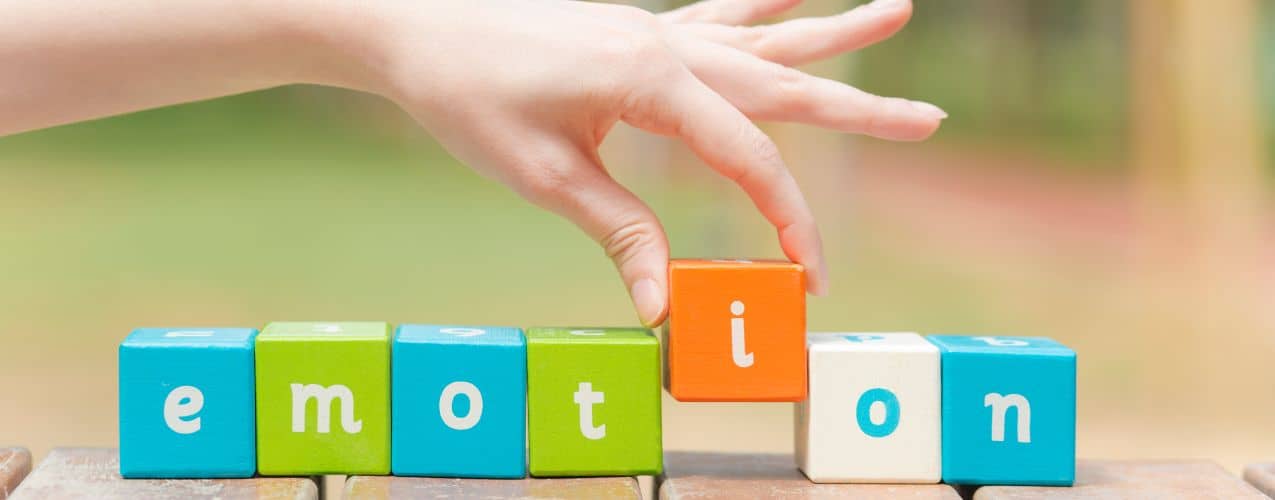
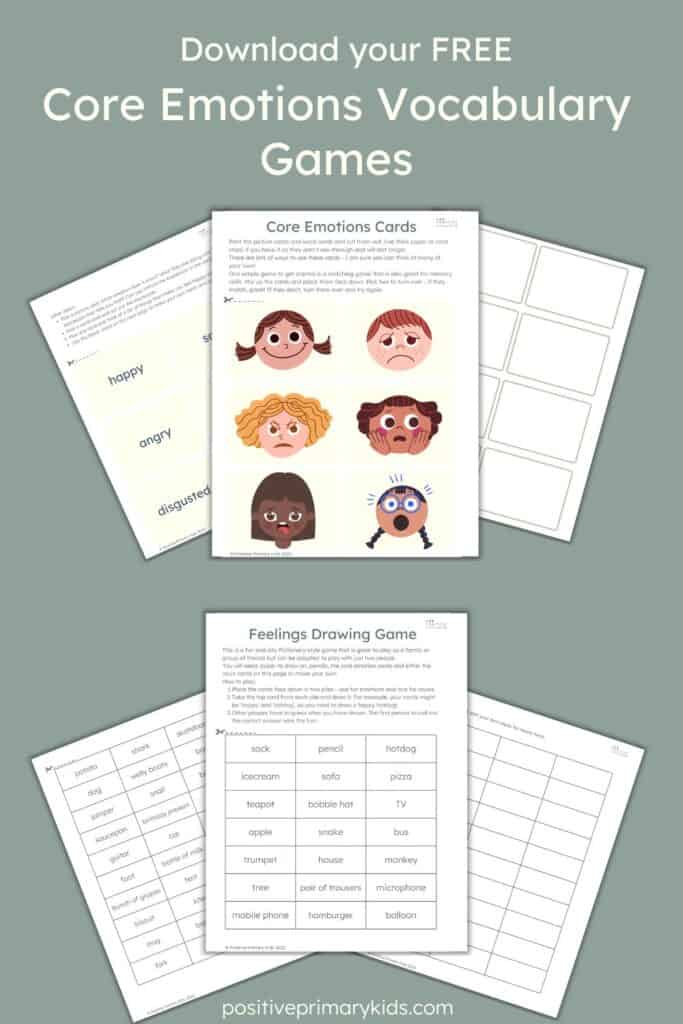
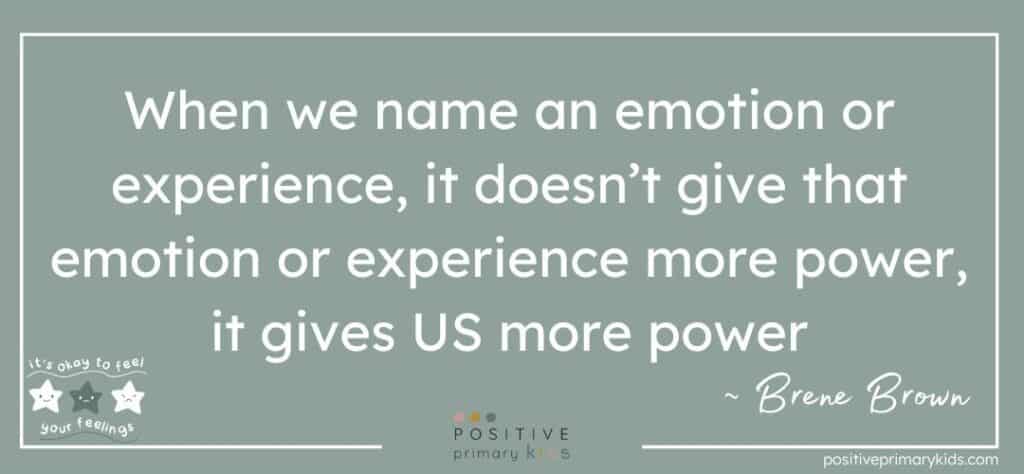



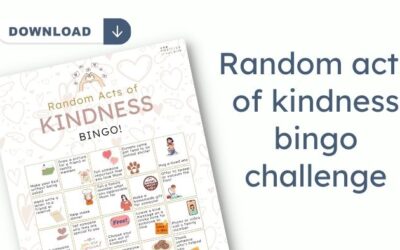
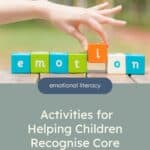
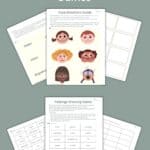
Thanks!